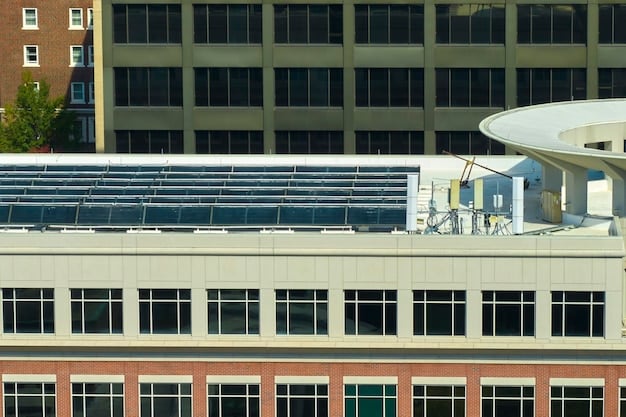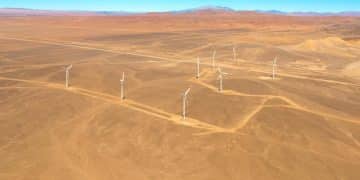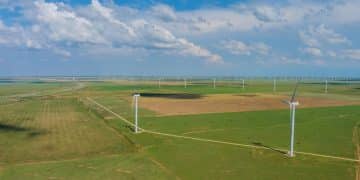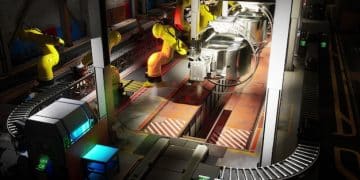Energy Prices Surge: How US Businesses Can Cut Energy Costs

As oil prices surge to $90 a barrel, US businesses face increasing energy costs; this article explores strategic measures to reduce consumption and mitigate financial impact, including energy audits, technology upgrades, and renewable energy adoption.
With oil prices hitting $90 a barrel, American businesses are feeling the pinch. Implementing effective energy strategies is now crucial for maintaining profitability and competitiveness. This article provides actionable insights into how US businesses can reduce energy consumption and costs.
Understanding the Impact of Rising Oil Prices on US Businesses
Rising oil prices have a cascading effect across the US economy, impacting various sectors from transportation to manufacturing. Understanding these impacts is the first step in developing effective mitigation strategies.
The Ripple Effect Across Industries
Increased oil prices directly translate to higher operating costs for businesses. This surge not only affects transportation and logistics but also impacts production costs and consumer prices.
For example, companies relying heavily on trucking for deliveries face increased fuel surcharges, cutting into profit margins. Manufacturers using oil-based materials experience higher raw material costs, potentially leading to price increases for consumers.
Key Affected Sectors
Several sectors bear the brunt of rising oil prices. These include:
- Transportation: Airlines, trucking, and shipping companies face higher fuel expenses.
- Manufacturing: Industries using plastic and other oil-derived materials see increased costs.
- Agriculture: Farming operations relying on fuel for machinery and transportation are affected.
- Retail: Increased transportation costs impact the prices of goods, potentially reducing consumer spending.

Businesses across these sectors must adopt proactive strategies to manage these increased costs and maintain competitiveness in a volatile market.
In conclusion, understanding the broad impact of rising oil prices is essential for US businesses as it enables them to prepare and adapt. By identifying the specific ways their operations are affected, companies can implement targeted strategies to reduce energy consumption and mitigate financial strain.
Conducting an Energy Audit: The First Step to Savings
An energy audit is a comprehensive assessment of a building’s energy use, identifying areas of inefficiency and potential cost savings. This crucial first step helps businesses understand their energy consumption patterns.
What is an Energy Audit?
An energy audit involves a thorough examination of a facility’s energy usage, including lighting, HVAC systems, equipment, and building envelope. Trained professionals assess energy performance and recommend measures to improve efficiency.
The audit typically includes:
- Detailed Analysis: Collection of data on energy consumption
- Equipment Inspection: Examination of systems and machinary
- Recommendations: Identification of potential upgrades and improvements
Types of Energy Audits
There are several types of energy audits, each offering a different level of detail and analysis:
- Walk-Through Audit: A basic assessment to identify obvious energy-saving opportunities.
- Energy Survey: A more detailed analysis of energy consumption, with specific recommendations.
- Investment-Grade Audit: A comprehensive audit providing detailed engineering and cost analysis for major energy upgrades.
Choosing the right type of audit depends on the size and complexity of the business.
To conclude, conducting an energy audit is an essential first step for US businesses looking to cut energy costs. By understanding their energy usage and identifying areas of inefficiency, businesses can prioritize investments in energy-saving measures and achieve significant cost savings.
Investing in Energy-Efficient Equipment and Technologies
Upgrading to energy-efficient equipment and adopting new technologies can significantly reduce energy consumption. This investment leads to long-term cost savings and improved operational efficiency.
Benefits of Energy-Efficient Equipment
Energy-efficient equipment not only reduces energy consumption but also offers numerous other benefits:
- Lower Operating Costs: Reduced energy bills directly impact the bottom line.
- Increased Productivity: Modern equipment often performs better and faster.
- Extended Lifespan: Energy-efficient equipment is typically more durable.
Available Technologies
Several energy-efficient technologies are available to US businesses:
- LED Lighting: Reduces energy use by up to 75% compared to traditional lighting.
- Smart Thermostats: Optimizes HVAC system performance.
- High-Efficiency HVAC Systems: Reduces energy consumption for heating and cooling.

Government Incentives and Rebates
The US government offers various incentives and rebates to encourage businesses to invest in energy-efficient equipment. These incentives can significantly reduce the upfront costs of upgrades.
These incentives include:
- Tax Credits: Deductions on federal taxes for energy-efficient investments.
- Rebates: Financial incentives from utility companies for purchasing energy-efficient equipment.
- Grants: Financial aid from government agencies for energy-saving projects.
In conclusion, investing in energy-efficient equipment and technologies is a smart move for US businesses looking to cut energy costs. By leveraging available technologies and taking advantage of government incentives, businesses can achieve significant savings and improve their bottom line.
Optimizing HVAC Systems for Maximum Efficiency
Heating, ventilation, and air conditioning (HVAC) systems are major energy consumers in most businesses. Optimizing these systems can lead to substantial energy savings and reduced operating costs.
HVAC System Maintenance
Regular maintenance is essential for ensuring HVAC systems operate efficiently. Neglecting maintenance can lead to reduced performance and increased energy consumption.
Key maintenance tasks include:
- Filter Replacement: Regular replacement of air filters ensures proper airflow.
- Coil Cleaning: Cleaning coils improves heat exchange efficiency.
- Duct Inspection and Sealing: Reduces air leaks and ensures efficient delivery of conditioned air.
Smart Thermostats and Zoning
Smart thermostats and zoning systems allow businesses to control the temperature in different areas of the building, optimizing energy use and reducing waste.
Smart thermostats offer features such as:
- Programmable Schedules: Sets temperature according to occupancy patterns.
- Remote Control: Adjusts settings from anywhere.
- Learning Capabilities: Adapts to user preferences over time.
Upgrading to High-Efficiency HVAC Systems
Replacing older, inefficient HVAC systems with high-efficiency models can result in significant energy savings. Modern systems are designed to consume less energy while maintaining optimal performance.
When upgrading, consider:
- Energy Star Ratings: Choose models that meet Energy Star standards.
- SEER and HSPF Ratings: Look for high Seasonal Energy Efficiency Ratio (SEER) and Heating Seasonal Performance Factor (HSPF) ratings.
- Professional Installation: Ensure proper installation for optimal performance.
In conclusion, optimizing HVAC systems is a crucial step for US businesses seeking to reduce energy consumption and cut costs. Implementing regular maintenance, utilizing smart technologies, and upgrading to high-efficiency systems can lead to substantial savings.
Embracing Renewable Energy Sources
Transitioning to renewable energy sources is a sustainable solution for US businesses looking to reduce their carbon footprint and lower energy costs. Renewable energy offers long-term savings and environmental benefits.
Solar Power
Solar power is one of the most accessible and cost-effective renewable energy options for businesses. Solar panels convert sunlight into electricity, reducing reliance on traditional energy sources.
Benefits of solar power include:
- Reduced Energy Bills: Solar power can significantly lower monthly energy expenses.
- Tax Incentives and Rebates: Government incentives make solar installations more affordable.
- Environmental Benefits: Solar power reduces carbon emissions and reliance on fossil fuels.
Wind Energy
Wind energy is another viable renewable energy option, particularly for businesses located in areas with consistent wind resources. Wind turbines convert wind into electricity.
Considerations for wind energy include:
- Location: Wind turbines require adequate wind resources to be effective.
- Space Requirements: Wind turbines require sufficient space for installation and operation.
- Initial Investment: The upfront cost of wind turbine installation can be significant.
Other Renewable Energy Options
Other renewable energy options include geothermal energy, biomass, and hydropower. These options may be suitable for certain businesses depending on their location and energy needs.
These alternatives offer:
- Geothermal Energy: Uses heat from the earth to generate electricity or provide heating and cooling.
- Biomass: Utilizes organic matter to produce electricity or heat.
- Hydropower: Harnesses the energy of moving water to generate electricity.
In conclusion, embracing renewable energy sources is a strategic move for US businesses. By investing in solar, wind, or other renewable energy options, businesses can reduce their carbon footprint, lower energy costs, and contribute to a more sustainable future.
Employee Training and Engagement
Engaging employees in energy conservation efforts is essential for achieving long-term energy savings. Educating and training employees can lead to a more energy-conscious workplace.
Training Programs
Implementing training programs can educate employees on energy conservation practices and promote a culture of sustainability within the workplace.
Training programs should cover topics such as:
- Energy Conservation Tips: Simple actions employees can take to reduce energy consumption.
- Equipment Usage: Best practices for using equipment efficiently.
- Company Initiatives: Information on company-wide energy-saving initiatives.
Incentive Programs
Incentive programs can motivate employees to actively participate in energy conservation efforts. Rewarding employees for their contributions can drive significant energy savings.
Types of incentive programs include:
- Recognition Programs: Acknowledging employees who demonstrate outstanding energy-saving behaviors.
- Financial Rewards: Providing bonuses or other financial incentives for achieving energy-saving goals.
- Team Competitions: Organizing team-based competitions to encourage energy conservation efforts.
Promoting Awareness
Raising awareness about energy conservation can help create a more energy-conscious workplace. Utilizing internal communication channels can promote energy-saving tips and initiatives.
Methods for promoting awareness include:
- Newsletters: Sharing energy-saving tips and company updates in internal newsletters.
- Posters and Signage: Displaying posters and signs with energy-saving reminders.
- Meetings and Presentations: Discussing energy conservation topics in meetings and presentations.
In conclusion, employee training and engagement are crucial for achieving long-term energy savings in US businesses. By educating, incentivizing, and promoting awareness, businesses can foster a culture of sustainability and drive significant reductions in energy consumption.
| Key Point | Brief Description |
|---|---|
| 💡 Energy Audit | Identify energy inefficiencies to prioritize savings. |
| 🛠️ Efficient Equipment | Upgrade to technologies like LED lighting & smart thermostats. |
| ☀️ Renewable Energy | Consider solar panels and wind energy for long-term savings. |
| 🧑🤝🧑 Employee Engagement | Train & incentivize employees to conserve energy daily. |
Frequently Asked Questions (FAQ)
▼
An energy audit assesses energy use to identify inefficiencies and savings. It’s important because it helps businesses understand their energy consumption and prioritize improvements.
▼
LED lighting is much more energy-efficient than traditional lighting, using up to 75% less electricity. This can lead to lower energy bills and significant cost savings.
▼
Smart thermostats optimize HVAC system performance by adjusting the temperature based on occupancy and preferences. This reduces energy waste and lowers heating and cooling costs.
▼
Solar power can be a great option, especially with tax incentives. Assess your building’s roof and energy needs to determine if solar panels are a good fit for your business.
▼
Training programs and incentives help promote energy conservation. Simple reminders, competitions, and rewards can significantly impact employee behavior and reduce energy usage.
Conclusion
As oil prices continue to rise, US businesses must proactively address energy consumption to maintain profitability. By conducting energy audits, investing in efficient technologies, embracing renewable energy, and engaging employees, businesses can significantly reduce energy costs and build a more sustainable future.





